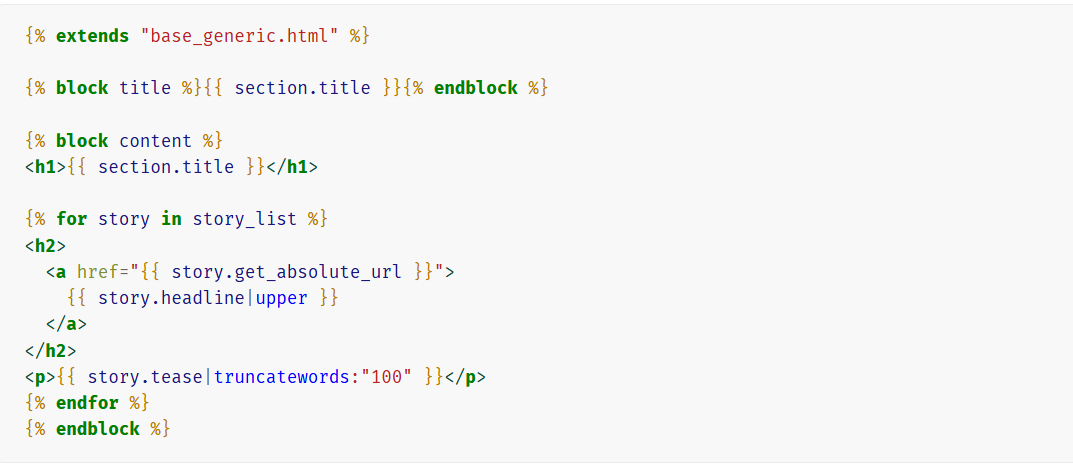
In the world of web development, static HTML pages are like photographs – beautiful snapshots, but ultimately unchanging.
To bring a website to life, to make it interactive and personalized, we need dynamic content.
This is where templating systems step onto the stage, acting as the bridge between the backend logic and the frontend presentation.
And in the Python-powered world of Django, its templating system stands out as a robust, elegant, and highly efficient solution.
At its core, Django’s templating system allows developers to write HTML-like code that can be dynamically populated with data from the application’s backend.
Think of a recipe: the template is the basic structure of the dish, while the ingredients (the data) are added just before serving, resulting in a unique and flavorful outcome each time.
The Anatomy of a Django Template
A Django template is essentially a text file, usually with a .html extension (though other extensions can be used). Within this file, standard HTML coexists with special constructs that Django’s template engine understands.
These constructs fall into a few key categories:
1. Variables: The workhorses of dynamic content, variables allow you to display data passed from your Django views. They are enclosed in double curly braces: {{ variable_name }}.
Imagine a view that fetches a user’s name. In your template, you could display it like this:
<h1>Hello, {{ user.name }}!</h1>
Django’s template engine will then replace {{ user.name }} with the actual name of the logged-in user. You can access attributes of objects using dot notation, as seen above.
2. Tags: These provide logic and control flow within your templates. Tags are enclosed in curly braces and percent signs: {% tag_name %}. Many built-in tags offer functionalities like:
-
{% if %},{% elif %},{% else %},{% endif %}: Conditional logic, allowing you to display different content based on certain conditions.{% if user.is_authenticated %} <p>Welcome back!</p> {% else %} <p>Please log in.</p> {% endif %} -
{% for %},{% empty %},{% endfor %}: Looping through iterables like lists or dictionaries.<ul> {% for item in item_list %} <li>{{ item.name }}</li> {% empty %} <li>No items available.</li> {% endfor %} </ul> -
{% csrf_token %}: Essential for security, this tag generates a unique token to prevent Cross-Site Request Forgery (CSRF) attacks in forms.<form method="post"> {% csrf_token %} <button type="submit">Submit</button> </form> -
{% url %}: This tag reverses a URL name defined in yoururls.pyfile into its corresponding URL. This is crucial for avoiding hardcoding URLs in your templates, making your application more maintainable.<a href="{% url 'view_profile' user.id %}">View Profile</a> -
{% static %}: Used for linking to static files like CSS, JavaScript, and images. It leverages Django’s static file management.<link rel="stylesheet" href="{% static 'css/style.css' %}"> <img src="{% static 'images/logo.png' %}" alt="My Logo">
3. Filters: These are used to modify the output of variables. Filters are applied using a pipe symbol (|) after the variable name: {{ variable_name|filter_name }}.
Django comes with a rich set of built-in filters, and you can even create your own. Some common filters include:
lower: Converts a string to lowercase.{{ "HELLO"|lower }}will outputhello.upper: Converts a string to uppercase.{{ "world"|upper }}will outputWORLD.date: Formats a date object according to a specified format.{{ article.pub_date|date:"F j, Y" }}might output “May 19, 2025”.length: Returns the length of a list or string.{{ my_list|length }}.default: Provides a default value if a variable is False or undefined.{{ user.email|default:"No email provided" }}.escape: Escapes HTML special characters to prevent cross-site scripting (XSS) attacks. This is often applied automatically for security.
4. Comments: Just like in HTML, you can add comments to your Django templates using {# #}. These comments are not rendered in the final output.
{# This is a comment explaining this section #}
Template Inheritance: Building a Solid Foundation
One of the most powerful features of Django’s templating system is template inheritance. This allows you to create a base template that contains the common structure and elements of your website (like the header, footer, and navigation) and then extend this base template in individual page templates.
Base Template (base.html):
<!DOCTYPE html>
<html>
<head>
<title>{% block title %}My Website{% endblock %}</title>
<link rel="stylesheet" href="{% static 'css/global.css' %}">
{% block extra_head %}{% endblock %}
</head>
<body>
<header>
<h1>My Awesome Website</h1>
<nav>
<ul>
<li><a href="{% url 'home' %}">Home</a></li>
<li><a href="{% url 'about' %}">About</a></li>
{% block navigation %}{% endblock %}
</ul>
</nav>
</header>
<div class="content">
{% block content %}
{% endblock %}
</div>
<footer>
<p>© 2025 My Website</p>
</footer>
<script src="{% static 'js/main.js' %}"></script>
{% block extra_scripts %}{% endblock %}
</body>
</html>
In the base template, {% block block_name %} tags define areas that child templates can override or fill in.
Child Template (home.html):
{% extends 'base.html' %}
{% block title %}Home Page{% endblock %}
{% block content %}
<h2>Welcome to the Home Page!</h2>
<p>This is the main content of our website.</p>
{% endblock %}
{% block navigation %}
<li><a href="{% url 'contact' %}">Contact</a></li>
{% endblock %}
The {% extends 'base.html' %} tag at the top indicates that this template inherits from base.html.
The content within the {% block %} tags in home.html will then replace the corresponding blocks in the base template.
Any content in the base template’s blocks that are not overridden will be used as the default.
This system promotes code reusability and makes maintaining a consistent look and feel across your website much easier.
Rendering Templates in Django Views
The magic of connecting your Python code to your templates happens within your Django views.
When a user requests a certain URL, a corresponding view function is executed.
This view function can then fetch data from your models, perform calculations, and finally render a template, passing the data as a context.
from django.shortcuts import render
from .models import Product
def product_list(request):
products = Product.objects.all()
context = {'products': products}
return render(request, 'products/list.html', context)
In this example, the product_list view retrieves all Product objects from the database.
It then creates a dictionary called context, where the keys are the variable names that will be available in the template, and the values are the corresponding Python objects.
The render() function takes the request object, the path to the template file ('products/list.html'), and the context dictionary as arguments. Django’s template engine then processes the list.html template, replacing the variables with the values from the context and rendering the final HTML response that is sent to the user’s browser.
Customizing the Templating System
Django’s templating system is highly extensible. You can create your own:
- Custom Filters: If the built-in filters don’t quite meet your needs, you can write your own Python functions to manipulate template variables.
- Custom Tags: For more complex logic that goes beyond simple variable manipulation, you can create custom template tags, which can even interact with your Django models and views.
- Template Loaders: Django uses template loaders to find template files. You can configure different loaders or even write your own to load templates from various sources.
To create custom filters and tags, you typically create a templatetags directory within your app directory and define your filters and tags in Python files within that directory. You then need to load these custom functionalities in your templates using the {% load %} tag.
Security Considerations
While Django’s templating system is powerful, it’s crucial to be aware of security implications. By default, Django automatically escapes HTML special characters in template variables to prevent XSS attacks. However, there are situations where you might need to output raw HTML.
In such cases, be extremely cautious and ensure that the data you are outputting is from a trusted source. The safe filter can be used to mark a variable as safe to render without escaping, but use it judiciously.
The Power and Elegance of Django Templates
Django’s templating system strikes a balance between power and simplicity. It allows developers to separate the presentation layer from the application logic, leading to cleaner, more maintainable code.
The intuitive syntax, the wealth of built-in features, and the extensibility options make it a joy to work with.
From rendering simple data to implementing complex conditional logic and reusable layouts, Django templates are an indispensable tool for building dynamic and engaging web applications!



